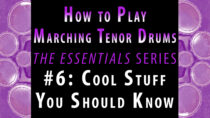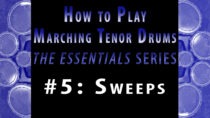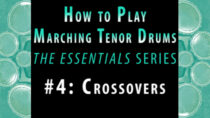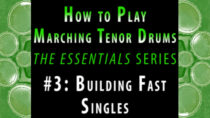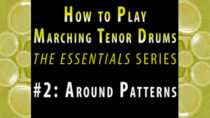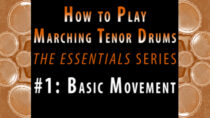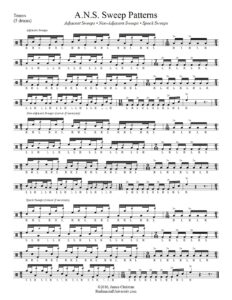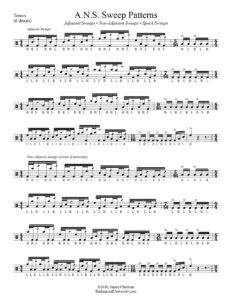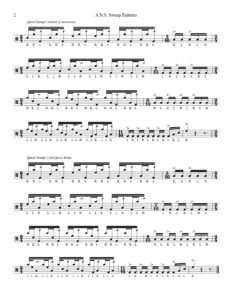When I released the first video in this marching tenor drums series, I gave a broad overview of what each video would cover. I listed video #6 as “Essential Vocabulary.” But honestly, doesn’t “Cool Stuff You Should Know” have a better ring to it? Either way, this lesson covers the essential tenor vocabulary not previously covered. After watching this, you will Read more “How to Play Marching Tenor Drums, part 6 of 7: Cool Stuff You Should Know”
Tag: quint toms
How to Play Marching Tenor Drums, Part 5 of 7: Sweeps & Scrapes
It’s time to work on sweeps and scrapes! Check out the newest video:
Sweeps, scrapes, split doubles–whatever you prefer to call them, this video breaks them down in detail. You’ll find a lot here. Learn the differences between adjacent sweeps, non-adjacent sweeps, spock sweeps, outward sweeps, inward sweeps, and push-pull sweeps. A full transcript of the video is below, along with links to the solos mentioned.
I would really, really like to hear your feedback on this particular video. I think the terminology descriptions have the potential to revolutionize the Read more “How to Play Marching Tenor Drums, Part 5 of 7: Sweeps & Scrapes”
How to Play Marching Tenor Drums, Part 4 of 7: Crossovers
It’s crossover week! Check out the newest video:
This 7-part series becomes more interesting as crossovers–a true staple of tenor drumming–are explored in a variety of ways. This video covers 13 crossover patterns, including a long “Crossover Builders” exercise that goes through all 18 crossover positions.
The “Crossover Builders” exercise and a transcript of the video are included below. Just a reminder: If you don’t already have Read more “How to Play Marching Tenor Drums, Part 4 of 7: Crossovers”
How to Play Marching Tenor Drums, Part 3 of 7: Building Fast Singles
Today we focus on building fast singles! In part 1, we covered playing zones and basic movement. In part 2, we covered basic around patterns. Now, we build upon this foundation and start Read more “How to Play Marching Tenor Drums, Part 3 of 7: Building Fast Singles”
How to Play Marching Tenor Drums, Part 2 of 7: Around Patterns
In part 1, we started with general movement principles, and we now come to basic around patterns with standard drum rudiments. This is the material I usually show first-time players on day one (exercises included below).
If you have been playing tenors for any length of time, these patterns should Read more “How to Play Marching Tenor Drums, Part 2 of 7: Around Patterns”
How to Play Marching Tenor Drums, Part 1 of 7: Basic Movement
Over the years, many of my students have wanted to learn how to play marching tenor drums. As much as time allowed, I would work with them individually and share the resources I had. Unfortunately, I was limited by space and time. Some of the existing resources were helpful, but students still struggled to know how to go forward on their own. Well, I saw a need and decided to do something about it. In order to multiply my impact and provide a ton of new material, I Read more “How to Play Marching Tenor Drums, Part 1 of 7: Basic Movement”
Snare & Multi-Tenors Exercise: 12 Bucks
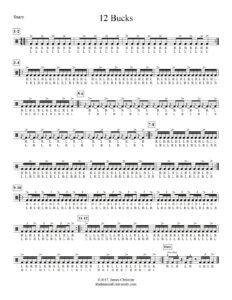
Click on the image to enlarge or click here to download in PDF format.
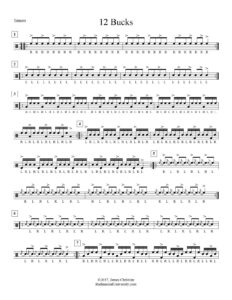
Click on the image to enlarge…
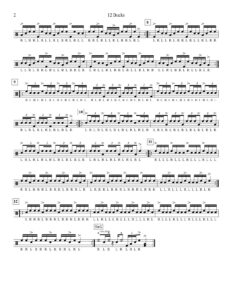
This exercise has gone through many tweaks and additions over the years. In its current version, I think it’s a great tool in the arsenal of any percussionist. When I first encountered this exercise, the first four sections were taught to me and the other students at Princeton High School (Princeton, Texas) by Rick Beckham. This covered the accented 8th notes off the right hand and left hand, plus the accented 16th notes off the right hand and left hand. He later added the next four sections (8th note flams leading with the right and left, plus the accented paradiddle patterns leading with the right and left).
The four main patterns—8th notes, 16th notes, flams, and paradiddles—are great for developing the control needed to distinguish accent and tap heights. I have used this core exercise with several different drum lines, and it has been quite effective.
Over time, I decided to expand the exercise. In personal practice, I used the basic accent structure on a number of different rudimental patterns. When teaching it to a full drum line, I decided that I wanted to write a mallet part that went through the circle of fifths, covering all 12 major keys.* I also wanted a bass drum part that worked split 16th note triplets and 32nd notes. So I picked two of my favorite rudimental patterns that worked with that rhythmic structure to add sections 9-10 and 11-12. In short, this exercise has something really useful for every section.
Since 12 sections are covered by going through the circle of fifths and the snare drum part is similar to the standard “Bucks” exercise, I decided to call the exercise “12 Bucks.” Here is the breakdown of the skills required for snare drum and tenors:
- Sections 1-2: One-handed accented 8th notes. Focus on maintaining a clear distinction between accents and taps. Keep your taps low and controlled. Make sure your accents are strong, not wimpy. The tenor exercise is deliberately on one drum, so that the player can focus on the Y-axis motion and the fundamental accent/tap control.
- Sections 3-4: Alternating accented 16th notes. This should follow the exact same technique as sections 1-2, except the opposite hand is now “filling in” the 16th notes. All taps should be consistently at the same height and volume. The tenors now move the accents to an adjacent drum. Keep the accents strong and the taps consistently softer.
- Sections 5-6: Alternating 8th note flams. These sections are excellent for focusing on the three heights of accents, taps, and grace notes. The accents and taps should remain the same from the previous sections. The additional grace notes should be softer and lower than the taps. Once again, the tenors are deliberately on one drum in order to focus on the fundamentals of good flam technique.
- Sections 7-8: 16th note paradiddles. These patterns get a bit trickier. Watch out for the sticking on measures 2 and 4! The key to these section is that they should sound the same as the 16th notes in sections 3-4. Do not let the “diddle” part of the paradiddles sound weaker or stronger than the singles you played in sections 3-4.
- Sections 9-10: Single stroke fours and single stroke sevens. These rudimental patterns get your hands moving a bit quicker with the 16th note triplets. They also require more precise timing focus. Many drummers have a tendency to “cheat” the length of the initial 8th note by starting the triplet too soon. Of course, you should practice the whole exercise with a metronome, but this section would especially benefit from doing so.
- Sections 11-12: “RLLL” quad groupings. Once again, the 16th notes patterns should sound the same as sections 3-4 and 7-8. Of course, these sections require more finger control in order to move each hand at the speed of 16th notes.
- Tag ending: A final syncopated measure to cap off everything! Notice that the snare and tenor triplet rhythms are slightly different. The tenors start on the downbeat, while the snares conclude on the upbeat. Both parts should be played precisely in time in order to hear the tradeoff between sections.
Have fun learning these patterns. Once you have them down, be adventurous and create your own variations!
*[Yes, I know there are technically 15 keys, but I’m not going to get into that debate right now.]
Multi-Tenors Exercise: Paradiddle Pretzel
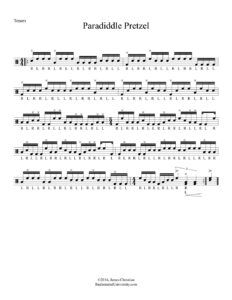
Here is a fun exercise that will put your arms in a pretzel. I won’t claim that this exercise is the most essential (or even the most logical) exercise ever, but it covers a lot of paradiddle patterns around the tenors—and it’s just plain fun to play. Some of the patterns are easier, and some of them are harder. There is a continual contrast between standard patterns and not-so-standard patterns that makes the overall flow tricky to navigate. Have fun with “Paradiddle Pretzel”!
Multi-Tenors Exercise: Triplet Around Patterns
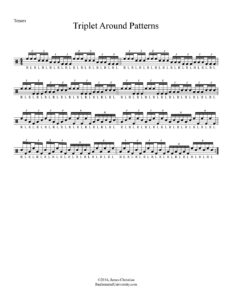
This exercise is a lot of fun to play. It utilizes only four drums, so it can be played on quad-toms, quint-toms, or sex-toms. You especially need two things to play this exercise well:
-
Endurance. As a constant barrage of single strokes, you have to dig deep and keep pushing to the end in order to play this exercise without stopping or slowing down.
-
Fluidity of Movement. Practically every combination of drums is covered here without using crossovers or spock drums. It’s important that you take each pattern slowly until you have the spatial memory to know where you’re going from phrase to phrase. Focus on striking in the proper playing zones and maintaining consistent note spacing.
For added endurance and accuracy practice, play this exercise through 10 times, 20 times, etc. Keep building new goals, and push yourself to get to the next level.
Multi-Tenors Exercise: A.N.S. Sweeps
Five-Drum Version
Six-Drum Version
To view the exercise, click on the images to enlarge. To download in PDF format, click here for the five-drum version, and click here for the six-drum version.
This exercise is written for either a five-drum setup or a six-drum setup. While the six-drum setup obviously has more options, the fundamental skills covered are about the same.
As the title indicates, this exercise focuses on sweep patterns. A sweep is a double stroke split among two different drums. The “A.N.S.” in the title stands for Adjacent Sweeps, Non-Adjacent Sweeps, and Spock Sweeps.
Adjacent sweeps are sweeps between two drums right next to each other. On the basic quad setup, this would cover sweeps between drums 2 & 4, 1 & 2, and 1 & 3. For a six-drum setup, this would also include the two spock drums.
Non-adjacent sweeps are sweeps between two drums not next to each other. On the basic quad setup, this would cover sweeps between drums 1 & 4, 2 & 3, and 3 & 4. (On the six-drum version of this exercise, I went ahead and included drum 4 to the farthest spock drum and drum 3 to the farthest spock drum. Technically, these would fall under what I call “spock sweeps,” but the movements are similar to non-adjacent sweeps, so they work here. These sweeps are somewhat of a gray area.) These sweeps require a farther reach than adjacent sweeps, and they are more difficult to play fast. When playing this exercise, feel free to take this section slower if needed.
Spock sweeps require a different type of movement than adjacent or non-adjacent sweeps. As the name indicates, these cover any sweeps utilizing the spock drum(s). When sweeping between the spock drum and drums 1 or 2, you must use a push-pull motion. This is quite difficult to play fast. Feel free to adjust the tempo on this section as well.
When it comes to tempo, take each section as fast as you can comfortably play it. Of course, you should initially start slowly to focus on your technique and accuracy. Once you have a solid foundation, you can start speeding it up. As always, focus on accuracy and great sound quality. If you keep hitting rims, slow down a little bit and reassess your aiming spot.
The odd-metered measures are intended to provide a little rhythmic interest between the sweep patterns. Focus on playing the 16th notes with steady time.
If you can play through this exercise smoothly, you will have a pretty solid grasp on all of the sweep combinations!

